语言类型学 Typology
第一编第六章 类型学

帕· 格林采尔:“文学时代”的类型 学
• 格林采尔把整个世界文学历史进程分为三 种大时代: • 其一,远古时代,艺术意识是神话类型; • 其二,恪守规范时代,属拘泥传统型; • 其三,历史主义时代,是个性化创作型。 • 认为类型学相似应在文学时代中去寻觅才 可靠。
其一,远古时代,艺术意识是神话 类型;
第一节 类型学研究史 及其基本理论
• 俄国尼· 康拉德《现代比较文艺学诸课 题》:“比较类型学的研究的任务, 也可以是从事发现彼此独立地兴起的 各现象所具有的类型共同性。例如, 依我看来,就可以证明西欧文学中的 骑士小说和日本文学中的‘军事记’、 欧洲启蒙时代的讽刺小说和中国19世 纪的暴露小说之间的类型学的相似。”
第一节 类型学研究史 及其基本理论
• 德国霍斯特· 吕迪格认为,“比较文学研究现在已 不再仅仅满足于确定‘影响’,而应把注意力集 中于独特的、在文艺美学上可以把握的接受类型 和方式。”比较文学研究偏爱具有世界性的文学 时代,具有世界性的作家。 • 德国W.威茨在其《从比较文学观点看莎士比亚》 (1890)一文中认为,比较文学应通过对类似现 象之间互相比较,深入到每一种个别现象最内在 的本质中去,并发现造成“类似和差异”的规律。
第一节 类型学研究史 及其基本理论
• 俄国米· 赫拉普钦科《作家的创作个性与文 学的发展》 • 文学的类型学要求揭示在语言和历史命运 方面相接近的一些民族的文学的共同的或 相似的发展倾向,同样也必须揭示并不具 有这些特点的一些民族的共同的或相似的 发展倾向。
第一节 类型学研究史 及其基本理论
• 俄国伊· 涅乌波科耶娃《世界文学史——系 统分析和比较分析问题》把世界文学历史 进程看作一个动态系统。 • 包括三个类型系统: • 时间类型——文学时代发展的各个时期; • 历史文化类型——文学之民族的地区的大 区域的系统; • 艺术类型系统——文学思潮、文学风格、 文学作品系统。
语言学精读书目(英文)
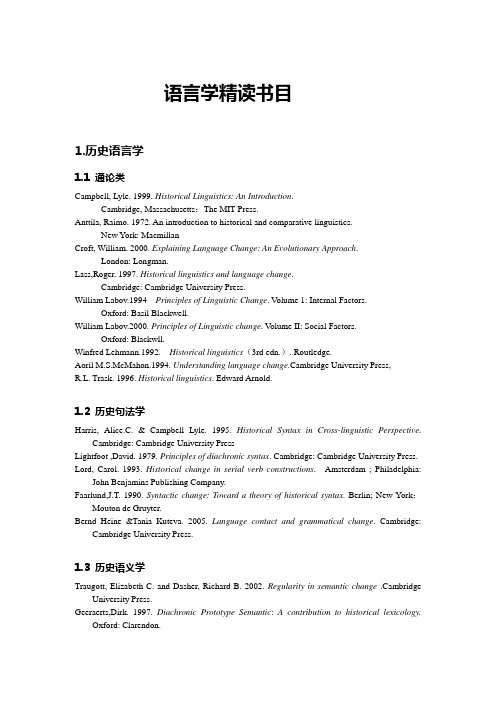
语言学精读书目1.历史语言学1.1 通论类Campbell, Lyle. 1999. Historical Linguistics: An Introduction.Cambridge, Massachusetts:The MIT Press.Anttila, Raimo. 1972. An introduction to historical and comparative linguistics.New York: MacmillanCroft, William. 2000. Explaining Language Change: An Evolutionary Approach.London: Longman.Lass,Roger. 1997. Historical linguistics and language change.Cambridge: Cambridge University Press.William Labov.1994 Principles of Linguistic Change. V olume 1: Internal Factors.Oxford: Basil Blackwell.William Labov.2000. Principles of Linguistic change. V olume II: Social Factors.Oxford: Blackwll.Winfred Lehmann.1992. Historical linguistics(3rd edn.). Routledge.Aoril M.S.McMahon.1994. Understanding language change.Cambridge University Press,R.L. Trask. 1996. Historical linguistics. Edward Arnold.1.2 历史句法学Harris, Alice.C. & Campbell Lyle. 1995. Historical Syntax in Cross-linguistic Perspective.Cambridge: Cambridge University PressLightfoot ,David. 1979. Principles of diachronic syntax. Cambridge: Cambridge University Press. Lord, Carol. 1993. Historical change in serial verb constructions. Amsterdam ; Philadelphia: John Benjamins Publishing Company.Faarlund,J.T. 1990. Syntactic change: Toward a theory of historical syntax. Berlin; New York;Mouton de Gruyter.Bernd Heine &Tania Kuteva. 2005. Language contact and grammatical change. Cambridge: Cambridge University Press.1.3 历史语义学Traugott, Elizabeth C. and Dasher, Richard B. 2002. Regularity in semantic change .Cambridge University Press.Geeraerts,Dirk. 1997. Diachronic Prototype Semantic:A contribution to historical lexicology.Oxford: Clarendon.Sweetser, Eve E.1990. From etymology to pragmatics: Metaphorical and cultural aspects of semantic structure. Cambridge: Cambridge University Press, 19901.4 历史语用学Arnovick,Lesliek. 1999. Diachronic Pragmatics. John Benjamins Publishing Company. Brinton, Laurel J. 1996. Pragmatic markers in English: Grammaticalization and discourse function. Berlin: Mouton de Gruyter.2.语法化研究Givo n, Talmy. 1979. On Understanding Grammar. New York: Academic Press.Heine, Bernd & Kuteva ,Tania. 2002 .World lexicon of grammaticalization.Cambridge: Cambridge University Press.Heine , Bernd, Ulrike Claudi & Friederike Hu nnemeyer. 1991. Grammaticalization : Aconceptual Framework. Chicago: University of Chicago Press.Bybee, Joan. , Revere Perkins, and William Pagliuca. 1994. The evolution of grammar: Tense, aspect and modality in the languages of the world. Chicago: University of Chicago Press. Hopper, Paul J .&Traugott, Elizabeth C. 2003. Grammaticalization, 2nd edition. Cambridge: Cambridge University Press.Lehmann, Christian. 1995[1982]. Thoughts on Grammaticalization. Munich: Lincom Europa.Xiu-Zhi Zoe WU.2004. Grammaticalization and Language Change in Chinese : A formal view London and New York: RoutledgeCurzonElly van Gelderen. 2004.Grammaticalization as Economy. Amsterdam/Philadelphia: John Benjamins Publishing CompanyBernd Heine and Tania Kuteva. 2005 Language Contact and Grammatical Change. Cambridge University Press.Ian Roberts and Anna Roussou.2003. SyntacticChange: A minimalist approach to grammaticaliza- tion. Canbridge:Cambridge University Press.Regine Eckardt. 2006. Meaning change in grammaticalization: an enquiry into semantic reanalysis New York : Oxford University Press.3.认知语言学Taylor, John R. 2005. Cognitive grammar.Oxford: Oxford University Press.Croft,William and D. A. Cruse.2004. Cognitive linguistics. (Cambridge Textbooks in Linguistics.) Cambridge: Cambridge University Press.Langacker,Ronald W. 1987/1991. Foundations of cognitive grammar,vol.1-2, Stanford: Stanford University Press.Lakoff, George.1987. Women, fire, and dangerous things: What categories reveal about the mind. Chicago: University of Chicago Press.Talmy, L. 2000, Toward a Cognitive Semantics. V ol.1& 2. Cambridge, Massachusetts: MIT Press.4.语言类型学Croft, William. 2003. Typology and Universals, 2nd edition. Cambridge: Cambridge University Press.Song, Jae Jung. 2001. Linguistic Typology: Morphology and syntax. Longman.Whaley, Linndsay J. 1997. Introduction to Typology: the unity and diversity of language. Thousand Oaks: Sage Publications.L.J.Whaley. 1997. Introduction to typology: The unity and diversity of language. Sage. Bernard Comrie. 1989. Languge universals and linguistic typology(2nd edition), University of Chicago Press.J.A.Hawkins. 1983. Word order universals. Academic Press.5.语用学、句法学与语义学5.1 句法学:Payne,Thomas E. 1997. Describing Morphosyntax. Cambridge: Cambridge University Press. Thomas E. Payne.2006. Exploring language Structure: A student’s guide. Cambridge University Press.Timothy Shopen. 1985. Language typology and syntactic Description. Cambridge University Press.Givo n, Talmy. 1984/1991. Syntax: A functional-typological introduction, V ol.I.II, Amsterdam: Benjamins,1984.5.2 语义学:Lyons, John. 1977. Semantics. Cambridge: Cambridge University Press.Saeed,John. 1997. Sementics. Blackwell Publishers.5.3 语用学:Levinson,Stephen C. 1983. Pragmatics. Cambridge: Cambridge University Press.Green,Georgia M. 1989. Pragmatics and natural language understanding .Hillsdale,NJ:Erlbaum Associates.5.4 其他:Schiffrin, Deborah. 1987. Discourse markers. Cambridge: Cambridge University Press.Karin Aijmer. 2002. English Discourse Particles: Evidence from a corpus. Amsterdam/ Philadelphia : John Benjamins Publishing Company.Verhagen, Arie. 2005. Constructions of intersubjectivity: Discourse, syntax,and cognition. Oxford:Oxford University Press.Dahl, Osten. 1985.Tense and aspect systems. Oxford: Basil Blackwell.Kemmer,Suzanne. 1993. The middle voice: A typological and diachronic study.Amsterdam: Benjamins.Bybee, Joan. 1985. Morphology: A study of the relation between meaning and form. Amsterdam: John Benjamins.Newmeyer, Fredrick J. Language form and language function. Cambridge;MA: MIT Press,1998 Croft,William. Syntactic categories and grammatical relations.Chicago: University of Chicago Press, 1991Haiman, John. Natural syntax: Iconicity and erosion. Cambridge: Cambridge University Press, 1985.Comrie, Bernard. 1976. Aspect: An introduction to the study of verbal aspect and related problems. Cambridge: Cambridge University Press.Comrie ,Bernard. 1985.Tense. Cambridge: Cambridge University Press.Palmer,F.R.2001. Mood and Modality. Second Edition. Cambridge: Cambridge University Press. Smith,Carlotta S.1991. The Parameter of Aspect. Dordrecht: Kluwer.Goldberg, A. E. 1995,Constructions: A Construction Grammar Approach to Argument Structure.Chicago: Chicago University Press.6.接触语言学:Thomason, Sarah G. 2001. Language contact: An introduction. Edinburgh University Press. Thomason, Sarah G. & Kaufman,Terrence.1988. Language contact, creolization, and genetic linguistics. Berkeley: University of California Press.Dixon, R.M.W. 1997. The rise and fall of languages. Cambridge: Cambridge University Press. Holm, J. 2004. Languages in contact. The partial restructuring of vernaculars. Cambridge: Cambridge University Press.Myers-Scotton, C. 2003. Contact linguistics. Oxford: Oxford University Press.Winford,Donald. 2003. An introduction to contact linguistics. Oxford: Blackwell.Aikhenvald, Alexandra Y. 2002. Language contact in Amazonia. New York: Oxford University Press.Enfield, N. J. 2003. Linguistic epidemiology: semantics and grammar of language contact in mainland Southeast Asia. London: Routledge Curzon.。
历史语言学和语言类型学
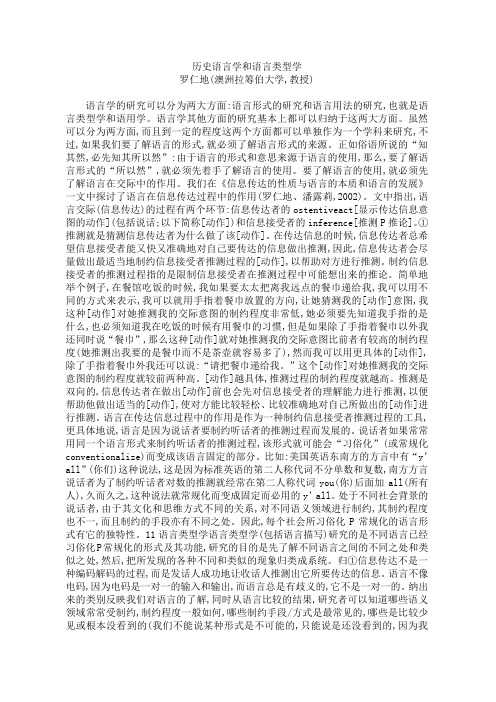
历史语言学和语言类型学罗仁地(澳洲拉筹伯大学,教授)语言学的研究可以分为两大方面:语言形式的研究和语言用法的研究,也就是语言类型学和语用学。
语言学其他方面的研究基本上都可以归纳于这两大方面。
虽然可以分为两方面,而且到一定的程度这两个方面都可以单独作为一个学科来研究,不过,如果我们要了解语言的形式,就必须了解语言形式的来源。
正如俗语所说的“知其然,必先知其所以然”:由于语言的形式和意思来源于语言的使用,那么,要了解语言形式的“所以然”,就必须先着手了解语言的使用。
要了解语言的使用,就必须先了解语言在交际中的作用。
我们在《信息传达的性质与语言的本质和语言的发展》一文中探讨了语言在信息传达过程中的作用(罗仁地、潘露莉,2002)。
文中指出,语言交际(信息传达)的过程有两个环节:信息传达者的ostentiveact[显示传达信息意图的动作](包括说话;以下简称[动作])和信息接受者的inference[推测P推论]。
①推测就是猜测信息传达者为什么做了该[动作]。
在传达信息的时候,信息传达者总希望信息接受者能又快又准确地对自己要传达的信息做出推测,因此,信息传达者会尽量做出最适当地制约信息接受者推测过程的[动作],以帮助对方进行推测。
制约信息接受者的推测过程指的是限制信息接受者在推测过程中可能想出来的推论。
简单地举个例子,在餐馆吃饭的时候,我如果要太太把离我远点的餐巾递给我,我可以用不同的方式来表示,我可以就用手指着餐巾放置的方向,让她猜测我的[动作]意图,我这种[动作]对她推测我的交际意图的制约程度非常低,她必须要先知道我手指的是什么,也必须知道我在吃饭的时候有用餐巾的习惯,但是如果除了手指着餐巾以外我还同时说“餐巾”,那么这种[动作]就对她推测我的交际意图比前者有较高的制约程度(她推测出我要的是餐巾而不是茶壶就容易多了),然而我可以用更具体的[动作],除了手指着餐巾外我还可以说:“请把餐巾递给我。
”这个[动作]对她推测我的交际意图的制约程度就较前两种高。
语言类型学视野下的文化话语观
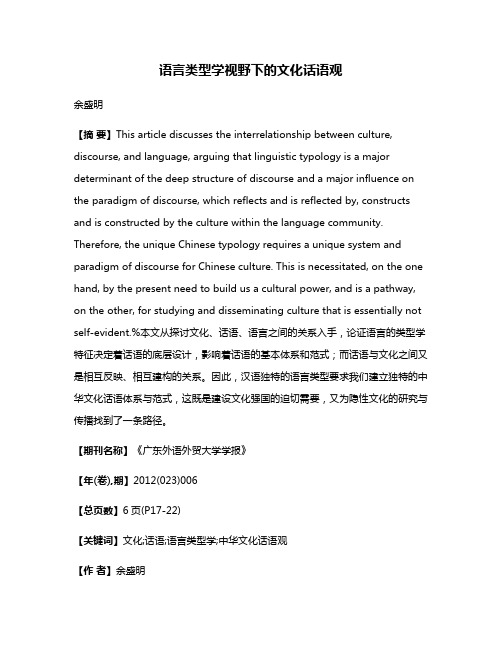
语言类型学视野下的文化话语观余盛明【摘要】This article discusses the interrelationship between culture, discourse, and language, arguing that linguistic typology is a major determinant of the deep structure of discourse and a major influence on the paradigm of discourse, which reflects and is reflected by, constructs and is constructed by the culture within the language community. Therefore, the unique Chinese typology requires a unique system and paradigm of discourse for Chinese culture. This is necessitated, on the one hand, by the present need to build us a cultural power, and is a pathway, on the other, for studying and disseminating culture that is essentially not self-evident.%本文从探讨文化、话语、语言之间的关系入手,论证语言的类型学特征决定着话语的底层设计,影响着话语的基本体系和范式;而话语与文化之间又是相互反映、相互建构的关系。
因此,汉语独特的语言类型要求我们建立独特的中华文化话语体系与范式,这既是建设文化强国的迫切需要,又为隐性文化的研究与传播找到了一条路径。
试析语言类型学的发展阶段及其特征
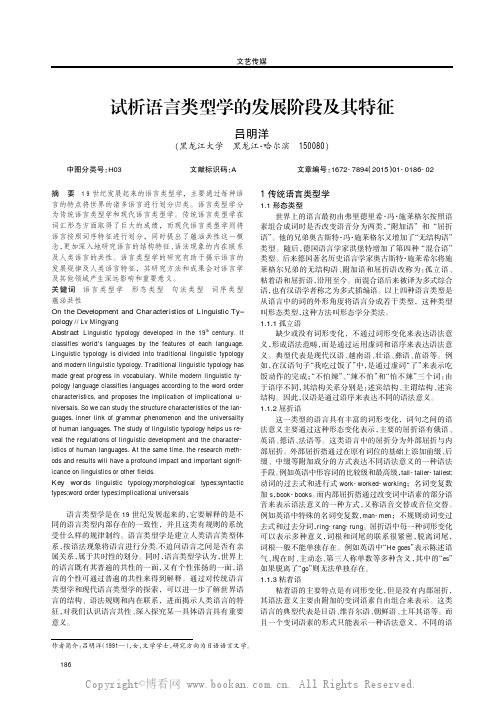
摘要19世纪发展起来的语言类型学,主要通过每种语言的特点将世界的诸多语言进行划分归类。
语言类型学分为传统语言类型学和现代语言类型学。
传统语言类型学在词汇形态方面取得了巨大的成绩,而现代语言类型学则将语言按照词序特征进行划分,同时提出了蕴涵共性这一概念,更加深入地研究语言的结构特征、语法现象的内在联系及人类语言的共性。
语言类型学的研究有助于揭示语言的发展规律及人类语言特征,其研究方法和成果会对语言学及其他领域产生深远影响和重要意义。
关键词语言类型学形态类型句法类型词序类型蕴涵共性On the Development and Characteristics of Linguistic Ty原pology//Lv MingyangAbstract Linguistic typology developed in the19th century.It classifies world's languages by the features of each language. Linguistic typology is divided into traditional linguistic typology and modern linguistic typology.Traditional linguistic typology has made great progress in vocabulary.While modern linguistic ty-pology language classifies languages according to the word order characteristics,and proposes the implication of implicational u-niversals.So we can study the structure characteristics of the lan-guages,inner link of grammar phenomenon and the universality of human languages.The study of linguistic typology helps us re-veal the regulations of linguistic development and the character-istics of human languages.At the same time,the research meth-ods and results will have a profound impact and important signif-icance on linguistics or other fields.Key words linguistic typology;morphological types;syntactic types;word order types;implicational universals语言类型学是在19世纪发展起来的,它要解释的是不同的语言类型内部存在的一致性,并且这类有规则的系统受什么样的规律制约。
TypInvent语言库存类型学(删减)

施诸己而不愿,亦勿施诸人 (话题结构中,表条件)
何事而不达?何为而不成? (宾语/补语的提升结构中)
• 梅广(2003):并列型语言(上古) → 主从型语言(中古)
• 上古汉语并列范畴显赫,“而”扩张其使用领域 • 试比较英语并列连词and
(1) Feature rank in the Latvian consonant inventory ‘拉脱 维亚语辅音库藏中的特征等级’ (Baiba I. Vilks的论文标题) (2) Early Vocabulary Inventory for Mandarin Chinese ‘汉 语普通话的早期词汇库藏’( Hao, M., Shu, H., Xing, A., & Li,
1995, 徐烈炯2002)等引起,探讨一种语言的基
本结构是注重表现话题或焦点(语用、话 语范畴),还是注重表现与施事、受事等 语义范畴关系更密切的主语、宾语(句法 范畴)。
库藏类型学的优势:
凸显类型学 库藏类型学 限于话题-焦点、主 覆盖语言的所有方面(语音、 词汇、语法等) 语-宾语领域 注重形式和范畴间的双向视 注重从语义语用范畴 角,且以形式到语义语用范 到语言形式的视角 畴的视角为出发点 特定语言中任何领域都有某 强调话语导向的某种 些范畴会凭借自身的库藏优 范畴义在特定语言中 势扩展成为显赫(凸显且强 被凸显 势)范畴
• 比较句强制使用比较级词形: He is taller/more diligent than me. • 比较级形式成为显赫的形态手段和范畴 • 比较级词形功能扩展:no longer , higher wage , shorter working time • 试比较汉语相应情况
语言类型学

语言类型学1.语言类型学的发展较早的语言类型学的研究主要是分类学意义上的,她可以追溯到19世纪初期的形态类型学,当时的语言学家施列格尔(Friedrich von Schlegel)根据语言在形态方面的特征,把语言分为附加语(affixal)和屈折语( inflectional)两种类型。
后来施列格尔的兄弟奥古斯特?施列格尔(August von Schlegel)又在前面的基础上加上了第三种类型:“无结构”语(nostructure),典型的如现代汉语[2?39]。
德国语言学家洪堡特(W ilhelm von Humboldt, 1836)又在以上学者的基础上增加了第四种类型:多式综合语( incor-porating language)。
如北美的一些语言,把动词和它的宾语整合成一个词汇形式。
多式综合语的词根上可以黏附多个语素用来表示各种语法意义,一个动词词根上面可以黏附表示“时”、“体”、“态”、“式”、“人称”、“数”等各种语法意义的语素,可以构成一个结构很复杂的“词”。
同样,名词的词形也有类似的语素组合形式,具有“数”、“格”等语法功能的语素与名词词根整合为一个词汇形式。
实际上,奥古斯特?施列格尔的三种类型“无结构”(no structure)、“附加”(affixal)、“屈折”( inflec-tional)即相当于奥古斯特?施莱希尔的孤立语( iso-lating,例如汉语、越南语等),黏着语(agglutinative,例如蒙古语、日语、芬兰语、匈牙利语、土耳其语)和屈折语( inflectiona,l例如德语、法语、俄语、阿拉伯语等)。
萨丕尔(Edward Sapir)根据构成词的语素的多寡将语言分为“分析语”(analytic) ,一个语素对应于一个词;“综合语”(syntheti c),少量的语素构成一个词;“多式综合语”(polysynthetic),数量上较多的语素、一些特定词根一起共同构成一个词。
语言类型学 Typology
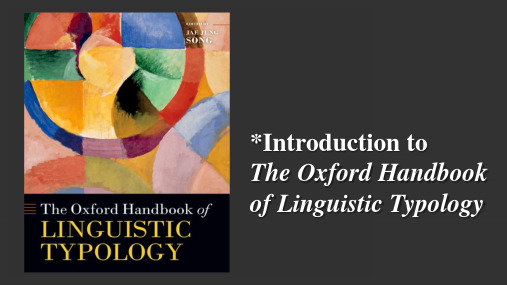
Ⅱ. Empirical Dimensions of Linguistic
2.2 Tense Typology 2.2.1 Absolute Tense In Yagua, there are five distinctions: two proximate tenses and three past tenses. They are exemplified below:
Ⅱ. Empirical Dimensions of Linguistic
2.2 Tense Typology 2.2.1 Absolute Tense If a language combines all three tenses, then we essentially have a tenseless language. e.g. In Chinese, 我去学校了。 Past
Ⅱ. Empirical Dimensions of Linguistic
2.2 Tense
Typology
Tense
Absolute Tense Relative Tense
When R ≠ S, we speak of relative tense. In the sentence John had left by 5:00 yesterday, E takes place before R (5:00 yesterday), which in turn takes place before S (now). E is measured against R and, secondarily, against S.
形态 词序 格标 音位 人标 时态体Байду номын сангаас词性
及物性 类型学 句法
自然语言处理及计算语言学相关术语中英对译表三_计算机英语词汇
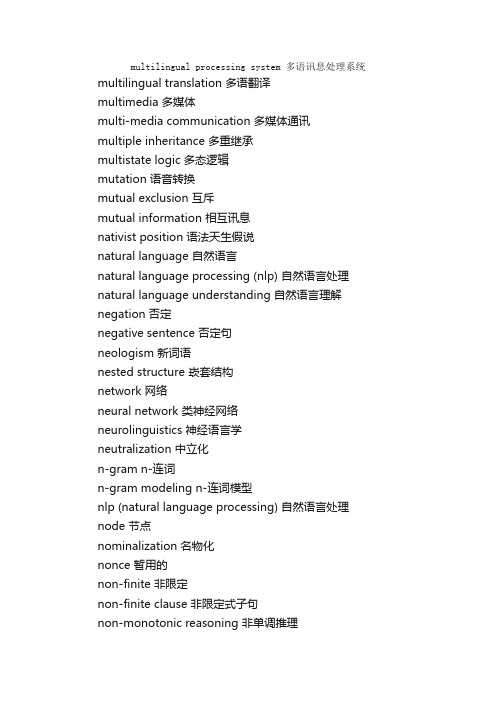
multilingual processing system 多语讯息处理系统multilingual translation 多语翻译multimedia 多媒体multi-media communication 多媒体通讯multiple inheritance 多重继承multistate logic 多态逻辑mutation 语音转换mutual exclusion 互斥mutual information 相互讯息nativist position 语法天生假说natural language 自然语言natural language processing (nlp) 自然语言处理natural language understanding 自然语言理解negation 否定negative sentence 否定句neologism 新词语nested structure 崁套结构network 网络neural network 类神经网络neurolinguistics 神经语言学neutralization 中立化n-gram n-连词n-gram modeling n-连词模型nlp (natural language processing) 自然语言处理node 节点nominalization 名物化nonce 暂用的non-finite 非限定non-finite clause 非限定式子句non-monotonic reasoning 非单调推理normal distribution 常态分布noun 名词noun phrase 名词组np (noun phrase) completeness 名词组完全性object 宾语{语言学}/对象{信息科学}object oriented programming 对象导向程序设计[面向对向的程序设计]official language 官方语言one-place predicate 一元述语on-line dictionary 线上查询词典 [联机词点]onomatopoeia 拟声词onset 节首音ontogeny 个体发生ontology 本体论open set 开放集operand 操作数 [操作对象]optimization 最佳化 [最优化]overgeneralization 过度概化overgeneration 过度衍生paradigmatic relation 聚合关系paralanguage 附语言parallel construction 并列结构parallel corpus 平行语料库parallel distributed processing (pdp) 平行分布处理paraphrase 转述 [释意;意译;同意互训]parole 言语parser 剖析器 [句法剖析程序]parsing 剖析part of speech (pos) 词类particle 语助词part-of relation part-of 关系part-of-speech tagging 词类标注pattern recognition 型样识别p-c (predicate-complement) insertion 述补中插pdp (parallel distributed processing) 平行分布处理perception 知觉perceptron 感觉器 [感知器]perceptual strategy 感知策略performative 行为句periphrasis 用独立词表达perlocutionary 语效性的permutation 移位petri net grammar petri 网语法philology 语文学phone 语音phoneme 音素phonemic analysis 因素分析phonemic stratum 音素层phonetics 语音学phonogram 音标phonology 声韵学 [音位学;广义语音学] phonotactics 音位排列理论phrasal verb 词组动词 [短语动词]phrase 词组 [短语]phrase marker 词组标记 [短语标记]pitch 音调pitch contour 调形变化pivot grammar 枢轴语法pivotal construction 承轴结构plausibility function 可能性函数pm (phrase marker) 词组标记 [短语标记] polysemy 多义性pos-tagging 词类标记postposition 方位词pp (preposition phrase) attachment 介词依附pragmatics 语用学precedence grammar 优先级语法precision 精确度predicate 述词predicate calculus 述词计算predicate logic 述词逻辑 [谓词逻辑]predicate-argument structure 述词论元结构prefix 前缀premodification 前置修饰preposition 介词prescriptive linguistics 规定语言学 [规范语言学] presentative sentence 引介句presupposition 前提principle of compositionality 语意合成性原理privative 二元对立的probabilistic parser 概率句法剖析程序problem solving 解决问题program 程序programming language 程序设计语言 [程序设计语言] proofreading system 校对系统proper name 专有名词prosody 节律prototype 原型pseudo-cleft sentence 准分裂句psycholinguistics 心理语言学punctuation 标点符号pushdown automata 下推自动机pushdown transducer 下推转换器qualification 后置修饰quantification 量化quantifier 范域词quantitative linguistics 计量语言学question answering system 问答系统queue 队列radical 字根 [词干;词根;部首;偏旁]radix of tuple 元组数基random access 随机存取rationalism 理性论rationalist (position) 理性论立场 [唯理论观点]reading laboratory 阅读实验室real time 实时real time control 实时控制 [实时控制]recursive transition network 递归转移网络reduplication 重叠词 [重复]reference 指涉referent 指称对象referential indices 指针referring expression 指涉词 [指示短语]register 缓存器[寄存器]{信息科学}/调高{语音学}/语言的场合层级{社会语言学}regular language 正规语言 [正则语言]relational database 关系型数据库 [关系数据库]relative clause 关系子句relaxation method 松弛法relevance 相关性restricted logic grammar 受限逻辑语法resumptive pronouns 复指代词retroactive inhibition 逆抑制rewriting rule 重写规则rheme 述位rhetorical structure 修辞结构rhetorics 修辞学robust 强健性robust processing 强健性处理robustness 强健性schema 基朴school grammar 教学语法scope 范域 [作用域;范围]script 脚本search mechanism 检索机制search space 检索空间searching route 检索路径 [搜索路径]second order predicate 二阶述词segmentation 分词segmentation marker 分段标志selectional restriction 选择限制semantic field 语意场semantic frame 语意架构semantic network 语意网络semantic representation 语意表征 [语义表示] semantic representation language 语意表征语言semantic restriction 语意限制semantic structure 语意结构semantics 语意学sememe 意素semiotics 符号学sender 发送者sensorimotor stage 感觉运动期sensory information 感官讯息 [感觉信息]sentence 句子sentence generator 句子产生器 [句子生成程序]sentence pattern 句型separation of homonyms 同音词区分sequence 序列serial order learning 顺序学习serial verb construction 连动结构set oriented semantic network 集合导向型语意网络 [面向集合型语意网络]sgml (standard generalized markup language) 结构化通用标记语言shift-reduce parsing 替换简化式剖析short term memory 短程记忆sign 信号signal processing technology 信号处理技术simple word 单纯词situation 情境situation semantics 情境语意学situational type 情境类型social context 社会环境sociolinguistics 社会语言学software engineering 软件工程 [软件工程]sort 排序speaker-independent speech recognition 非特定语者语音识别spectrum 频谱speech 口语speech act assignment 言语行为指定speech continuum 言语连续体speech disorder 语言失序 [言语缺失]speech recognition 语音辨识speech retrieval 语音检索speech situation 言谈情境 [言语情境]speech synthesis 语音合成speech translation system 语音翻译系统speech understanding system 语音理解系统spreading activation model 扩散激发模型standard deviation 标准差standard generalized markup language 标准通用标示语言start-bound complement 接头词state of affairs algebra 事态代数state transition diagram 状态转移图statement kernel 句核static attribute list 静态属性表statistical analysis 统计分析statistical linguistics 统计语言学statistical significance 统计意义stem 词干stimulus-response theory 刺激反应理论stochastic approach to parsing 概率式句法剖析 [句法剖析的随机方法]stop 爆破音stratificational grammar 阶层语法 [层级语法]string 字符串[串;字符串]string manipulation language 字符串操作语言string matching 字符串匹配 [字符串]structural ambiguity 结构歧义structural linguistics 结构语言学structural relation 结构关系structural transfer 结构转换structuralism 结构主义structure 结构structure sharing representation 结构共享表征subcategorization 次类划分 [下位范畴化] subjunctive 假设的sublanguage 子语言subordinate 从属关系subordinate clause 从属子句 [从句;子句] subordination 从属substitution rule 代换规则 [置换规则] substrate 底层语言suffix 后缀superordinate 上位的superstratum 上层语言suppletion 异型[不规则词型变化] suprasegmental 超音段的syllabification 音节划分syllable 音节syllable structure constraint 音节结构限制symbolization and verbalization 符号化与字句化synchronic 同步的synonym 同义词syntactic category 句法类别syntactic constituent 句法成分syntactic rule 语法规律 [句法规则]syntactic semantics 句法语意学syntagm 句段syntagmatic 组合关系 [结构段的;组合的] syntax 句法systemic grammar 系统语法tag 标记target language 目标语言 [目标语言]task sharing 课题分享 [任务共享] tautology 套套逻辑 [恒真式;重言式;同义反复] taxonomical hierarchy 分类阶层 [分类层次] telescopic compound 套装合并template 模板temporal inference 循序推理 [时序推理] temporal logic 时间逻辑 [时序逻辑] temporal marker 时貌标记tense 时态terminology 术语text 文本text analyzing 文本分析text coherence 文本一致性text generation 文本生成 [篇章生成]text linguistics 文本语言学text planning 文本规划text proofreading 文本校对text retrieval 文本检索text structure 文本结构 [篇章结构]text summarization 文本自动摘要 [篇章摘要] text understanding 文本理解text-to-speech 文本转语音thematic role 题旨角色thematic structure 题旨结构theorem 定理thesaurus 同义词辞典theta role 题旨角色theta-grid 题旨网格token 实类 [标记项]tone 音调tone language 音调语言tone sandhi 连调变换top-down 由上而下 [自顶向下]topic 主题topicalization 主题化 [话题化]trace 痕迹trace theory 痕迹理论training 训练transaction 异动 [处理单位]transcription 转写 [抄写;速记翻译]transducer 转换器transfer 转移transfer approach 转换方法transfer framework 转换框架transformation 变形 [转换]transformational grammar 变形语法 [转换语法] transitional state term set 转移状态项集合transitivity 及物性translation 翻译translation equivalence 翻译等值性translation memory 翻译记忆transparency 透明性tree 树状结构 [树]tree adjoining grammar 树形加接语法 [树连接语法] treebank 树图数据库[语法关系树库]trigram 三连词t-score t-数turing machine 杜林机 [图灵机]turing test 杜林测试 [图灵试验]type 类型type/token node 标记类型/实类节点type-feature structure 类型特征结构typology 类型学ultimate constituent 终端成分unbounded dependency 无界限依存underlying form 基底型式underlying structure 基底结构unification 连并 [合一]unification-based grammar 连并为本的语法 [基于合一的语法] universal grammar 普遍性语法universal instantiation 普遍例式universal quantifier 全称范域词unknown word 未知词 [未定义词]unrestricted grammar 非限制型语法usage flag 使用旗标user interface 使用者界面 [用户界面]valence grammar 结合价语法valence theory 结合价理论valency 结合价variance 变异数 [方差]verb 动词verb phrase 动词组 [动词短语]verb resultative compound 动补复合词verbal association 词语联想verbal phrase 动词组verbal production 言语生成vernacular 本地话v-o construction (verb-object) 动宾结构vocabulary 字汇vocabulary entry 词条vocal track 声道vocative 呼格voice recognition 声音辨识 [语音识别]vowel 元音vowel harmony 元音和谐 [元音和谐]waveform 波形weak verb 弱化动词whorfian hypothesis whorfian 假说word 词word frequency 词频word frequency distribution 词频分布word order 词序word segmentation 分词word segmentation standard for chinese 中文分词规范word segmentation unit 分词单位 [切词单位]word set 词集working memory 工作记忆 [工作存储区]world knowledge 世界知识writing system 书写系统x-bar theory x标杠理论 ["x"阶理论]zipf's law 利夫规律 [齐普夫定律]。
类型学

b.文学类型之间的相互影响也是文学 类型形成的重要方式之一。
相同文学现象之间的相互影响并不是通 过偶然的方式发生的,影响对文学类型的形 成往往意味着相似或相同的社会条件。 如,欧洲浪漫主义文学对中国现代文学 的影响(汇流); 中国小说文类的形成; “十四行诗”、话剧等
c. “隐性的遥契”所形成的类型
五、类型学研究的理论背景
• 运用社会学方法来研究民族间文学的关 系和国际文学的总体现象。
• 康拉德提出:
在比较文学研究的领域里应该做的头 一件事——甚至在西方研究者所划出的时 间范围(17之19世纪)上,——要断然扩 大空间的界限,要把整个文明人类的文学 之间的联系纳入研究轨道。在研究这样一 些联系并在更广泛的方面研究各种文学的 相互关系时,应该注意到各国的政治关系, 它们的文化水平,以及思维方式和世界观、 信仰、生活方式、甚至在各民族的趣味上 的差异。必须经常考虑每国的阶级关系、 政治和思想上的斗争。离开这些是不能了 解各种文学相互关系的真正性质的。
四、类型学相似的基本特征
• “类型学相似”指的是诸种文学文本之 间所共有的诗学品格,或者说它们与历 史上形成的某一种诗学类型在品质特征 上有共同特征。
• 例:在艺术意识上同属神话诗学类型的远 古时代,印度的《摩诃婆罗多》和《罗摩 衍那》、希腊的《伊利昂纪》和《奥德修 纪》、日耳曼、中亚和蒙古史诗,它们虽 属不同的民族、不同的语言、不同的文化, 但在诗学特征上有共通之处:叙事艺术上 共同的环形手法和情节链——神奇的降生、 英勇的童年、妻子被劫、异国旅行、战斗、 死里逃生;共同的结构模式(离别——寻 找——重逢),共同的人物类型,共同的 叙事风格,等等。
• 另一位德国比较学者埃尔温·科本也指 出: “可以从更广阔的角度去研究各种 ‘世界性’的文学潮流,如欧洲浪漫主 义,诗歌中的象征主义,并且指出这 类研究需要对各国文学的广博知识和 历史感,以及对美与文学理论要有敏 锐的感受。
浅谈语言类型学中具体语言的两种分类方法—基于语言共时同构关系的结构分类和基于语言历史同源关系的发生学

目录摘要 (2)关键词 (2)Abstract (2)Key words (2)一、语言类型学综述 (2)二、基于语言共时同构关系的结构分类 (4)(一)词汇类型学和语义类型学 (4)(二)语音类型学 (4)(三)语序类型学 (4)1.SVO (5)2.SOV (5)3.VSO (5)4.VOS (5)5.OSV (5)6.OVS (5)(四)语法类型学 (5)1.孤立语 (5)2.屈折语 (5)3.粘着语 (5)4.复综语 (5)三、基于语言历史同源关系的发生学分类 (5)四、两种分类方法的关系 (6)五、小结 (7)致谢 (7)参考文献 (7)浅谈语言类型学中具体语言的两种分类方法—基于语言共时同构关系的结构分类和基于语言历史同源关系的发生学分类汉语言文学专业学生赵石磊指导教师王永辉摘要:近年来,当代语言类型学逐渐兴起并得到初步发展,其研究方法和研究成果逐渐丰富起来,为语言学其它领域的研究和开拓起到了一定的指引作用。
作为语言类型学中的两个基本语言分类方法,基于语言共时同构关系的结构分类和基于语言历史同源关系的发生学分类得到了更多的关注.我认为,鉴于这对关系在语言类型学甚至在社会语言学中的重要性,有必要对它们进行一番综述和区分,即进行一番系统阐述,以明确语言类型学的地位和作用,明确其研究领域和研究范围及发展前景。
关键词:语言类型学;语言分类;语法结构类型;共时/历时;亲属关系The Brief Introduction of two Classification methods of concrete language in Linguistic Typology——Structure Classification based on Linguistic Synchronic form and Embryology based on LinguisticDiachronic origin relationshipStudent majoring in Chinese Zhao ShileiTutor Wang YonghuiAbstract:In recent years,the contemporary Linguistic Typology has been arising and developing initially.Its research methods and fruits become richer and richer,which in turn promots other linguistic fields research and explore.As the two basic classify methods of Liguistic Typology,Structure Classification based on Linguistic Synchronic form and Embryology based on Diachronic origin relationship arract more and more attention.In my opinion,in view of the significance of the couple relationship in Linguistic Typology even in Social Linguistic,there is great need to translate and distinguish them to make it clear that which status and function the Linguistic Typology has and what is its research area,research scope and develop prospect.Key words:Linguistic Typology;Linguistic Classification;Grammer StructureType;Synchronic/Diachronic;Relationship一、语言类型学综述作为当代语言学中的一门显学,语言类型学(Typology)近年来越来越多地受到语言学界各位专家学者们的关注。
语言类型学当代语言学中的一门显学
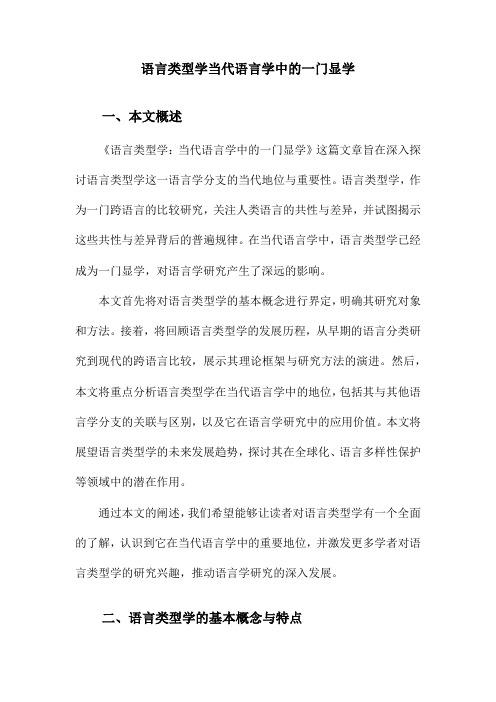
语言类型学当代语言学中的一门显学一、本文概述《语言类型学:当代语言学中的一门显学》这篇文章旨在深入探讨语言类型学这一语言学分支的当代地位与重要性。
语言类型学,作为一门跨语言的比较研究,关注人类语言的共性与差异,并试图揭示这些共性与差异背后的普遍规律。
在当代语言学中,语言类型学已经成为一门显学,对语言学研究产生了深远的影响。
本文首先将对语言类型学的基本概念进行界定,明确其研究对象和方法。
接着,将回顾语言类型学的发展历程,从早期的语言分类研究到现代的跨语言比较,展示其理论框架与研究方法的演进。
然后,本文将重点分析语言类型学在当代语言学中的地位,包括其与其他语言学分支的关联与区别,以及它在语言学研究中的应用价值。
本文将展望语言类型学的未来发展趋势,探讨其在全球化、语言多样性保护等领域中的潜在作用。
通过本文的阐述,我们希望能够让读者对语言类型学有一个全面的了解,认识到它在当代语言学中的重要地位,并激发更多学者对语言类型学的研究兴趣,推动语言学研究的深入发展。
二、语言类型学的基本概念与特点语言类型学,作为当代语言学中的一门显学,主要研究语言的结构普遍性和变异性,探寻人类语言的共性和差异。
其基本概念可以概括为对语言进行跨文化的比较和分析,从而揭示出语言现象的普遍规律和特殊现象。
跨文化比较:语言类型学强调对不同语言进行比较,以揭示语言现象的普遍性和变异性。
这种比较不仅限于同一语系或同一地理区域的语言,还包括了全球范围内不同语系和文化的语言。
结构主义视角:语言类型学倾向于从语言的结构出发,分析语言的音系、语法和词汇等方面的特点和规律。
它关注语言的内部结构和关系,而非语言的外部功能或社会文化背景。
共性追求:语言类型学致力于寻找人类语言的共性,即不同语言之间普遍存在的相似性和规律性。
这种共性可能是由人类认知的普遍结构或语言演变的共同规律所决定的。
描述性与解释性:语言类型学不仅关注对语言现象的客观描述,还强调对语言现象的解释和理论构建。
20年来汉藏语系的语言类型学研究
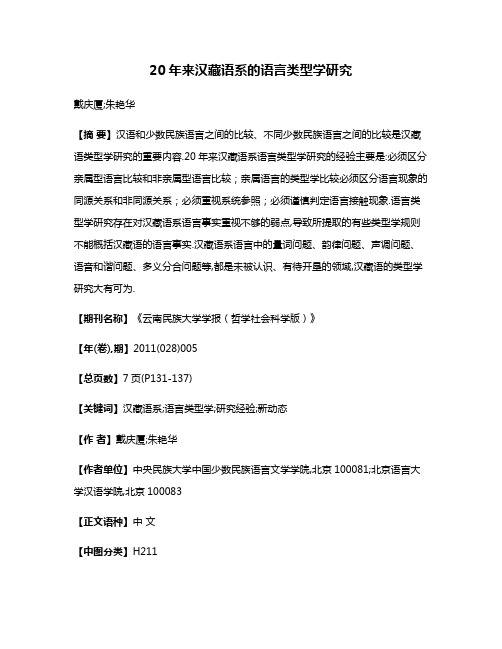
20年来汉藏语系的语言类型学研究戴庆厦;朱艳华【摘要】汉语和少数民族语言之间的比较、不同少数民族语言之间的比较是汉藏语类型学研究的重要内容.20年来汉藏语系语言类型学研究的经验主要是:必须区分亲属型语言比较和非亲属型语言比较;亲属语言的类型学比较必须区分语言现象的同源关系和非同源关系;必须重视系统参照;必须谨慎判定语言接触现象.语言类型学研究存在对汉藏语系语言事实重视不够的弱点,导致所提取的有些类型学规则不能概括汉藏语的语言事实.汉藏语系语言中的量词问题、韵律问题、声调问题、语音和谐问题、多义分合问题等,都是未被认识、有待开垦的领域,汉藏语的类型学研究大有可为.【期刊名称】《云南民族大学学报(哲学社会科学版)》【年(卷),期】2011(028)005【总页数】7页(P131-137)【关键词】汉藏语系;语言类型学;研究经验;新动态【作者】戴庆厦;朱艳华【作者单位】中央民族大学中国少数民族语言文学学院,北京100081;北京语言大学汉语学院,北京100083【正文语种】中文【中图分类】H211语言类型学(linguistic typology),又称类型语言学(typological linguistics),是通过比较不同语言相同、相异的特点,从复杂的、无限的语言现象中,归纳出少量的、有限的类型,寻找人类语言的普遍现象(即共性),以深化对语言本质、语言特点的认识。
现代语言类型学始于上世纪60年代,是20世纪现代语言学理论发展的热点之一。
中国是一个多语种国家,有极为丰富的语言资源,语言类型学理论与方法传入中国后很快就被一些语言学家所接受,用来研究汉语和少数民族语言,推动了中国语言的研究。
如何运用语言类型学理论与方法研究中国的语言,近期已经取得了一些经验。
汉藏语系语言(以下简称“汉藏语”)的类型学研究存在两类不同的对象:一类是汉藏语内部语言的比较;另一类是汉藏语和其他语系语言的比较。
两类对象性质不同,其方法也不同。
语言共性论文语言类型论文

语言共性论文语言类型论文摘要:英语和德语同属印欧语系的西日耳曼语支,两者在字母、语音、词汇和语法等方面都有较大的相近性,但在词序上却有显著不同。
本文在语言共性的视界下,试以语言类型学为切入点,从词序的角度对英、德两种语言进行对比,概括出两者词序上的不同:英语的词序相对固定,而德语的词序相对自由灵活得多。
关键词:语言共性;语言类型;词序;英语;德语一、引言当今人们对语言的研究出现了一个新的趋势:研究语言的共性(language universals)。
根据《朗曼应用语言学词典》,语言共性是指在所有已知的语言中出现的语言模式或现象(万文龙, 2007)。
研究语言共性的角度和方法有很多,格林伯格创立的语言类型学(language typology)就是其中一种。
它主要从语音、形态和句法上研究语言的共同点。
在句法层面上,语言可以按照多种特点分为不同类型。
其中最常见的就是按照它们的占支配地位的词序来分类(meyer, 2009)。
二、英语和德语的词序研究状况(一)词序的定义韦氏大辞典中给出的“词序”的定义是“词在短语、从句或句子中的顺序”,但在语言学中,这一术语是指利用词或句子成分在词组、短语或句子中的相互位次来表达语法意义的一种重要语法表现手法(罗苑霞, 2008),也可以称为“语序”。
基本词序在从句水平上包括三个主要成分:主语、谓语和宾语(宋在晶, 2008)。
根据主语、谓语、宾语在句子中出现的顺序,语言学家共提出了六种在逻辑上可能的类型,即“主宾谓”(sov)、“主谓宾”(svo)、“谓主宾”(vso)、“谓宾主”(vos)、“宾谓主”(ovs)、“宾主谓”(osv)。
(二)对英语词序的研究英语是svo语言的绝好例子,但英语的svo语序也是经历了一个漫长的过程才固定下来的,主要有三个时期:强屈折时期(古英语时期);弱屈折时期(中古英语时期);语序定型期(现代英语时期)。
(三)对德语词序的研究1970年后,语言学家们才开始讨论德语的语言类型学问题 (黎东良,朱小安, 2008)。
类型学视野

提出一个新的类型——多式综合语;
20 世纪语言类型学研究
1909 年德国语言学家芬克(F 〃 N〃 Finck)在论著《语言的主要 类型》将语言分为八类:
• 词根孤立语,如汉语;
• 词干孤立语, 如萨摩亚语(属波利尼西亚语族); • 词根屈折语,如阿拉伯语;
• 词根屈折语,如希腊语;
• 词组屈折语,如格鲁吉亚语; • 并列语,如苏比亚语(一种班图语); • 粘着语,如土耳其语; • 多式综合语,如爱斯基摩语。
(4) There is the woman about whom I read in the newspaper. (旁格宾语)
(5) T h e r e i s t h e w o m a n w h o s e s i s t e r graduated last year. (所有格) (6) There is the woman who I am older than. (比较宾语)
孤立语 屈折语 形态类型 粘着语 传统语言类型学 多式综合语 语 言 类 型 学 句法类型 分析语 综合语
现代语言类型学
语序类型
蕴含共性
19 世纪语言类型学研究
1808年, 施莱格尔(Friedrich von Schelegel)最早对语
言进行形态分类,在其著作《论印度人的语言和智慧》
1966年美国语言学家格林伯格在《语言的普遍现象》 (Universals of language)列举了24种可能的语言类型,其
中四种包含的语言类型最多:
• VSO / P r / N G / N A •SVO/Pr/NG/NA •SOV/Po/GN/AN • SO V / P o / G N / N A
语言库藏类型学构想
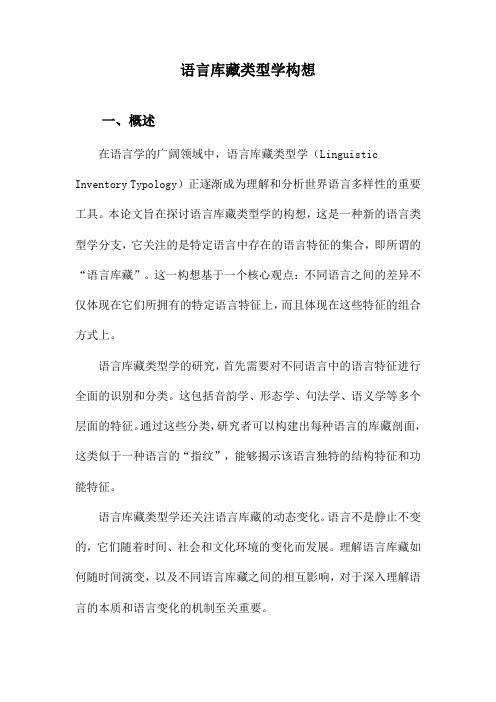
语言库藏类型学构想一、概述在语言学的广阔领域中,语言库藏类型学(Linguistic Inventory Typology)正逐渐成为理解和分析世界语言多样性的重要工具。
本论文旨在探讨语言库藏类型学的构想,这是一种新的语言类型学分支,它关注的是特定语言中存在的语言特征的集合,即所谓的“语言库藏”。
这一构想基于一个核心观点:不同语言之间的差异不仅体现在它们所拥有的特定语言特征上,而且体现在这些特征的组合方式上。
语言库藏类型学的研究,首先需要对不同语言中的语言特征进行全面的识别和分类。
这包括音韵学、形态学、句法学、语义学等多个层面的特征。
通过这些分类,研究者可以构建出每种语言的库藏剖面,这类似于一种语言的“指纹”,能够揭示该语言独特的结构特征和功能特征。
语言库藏类型学还关注语言库藏的动态变化。
语言不是静止不变的,它们随着时间、社会和文化环境的变化而发展。
理解语言库藏如何随时间演变,以及不同语言库藏之间的相互影响,对于深入理解语言的本质和语言变化的机制至关重要。
本论文将首先概述语言库藏类型学的基本原理和方法,然后通过具体的案例研究,探讨不同语言库藏的特点和相互关系。
本文将讨论语言库藏类型学对于语言学理论、语言教学、语言政策和跨文化交流等领域的重要意义,并展望未来研究的可能方向。
1. 研究背景及意义语言库藏类型学的定义与起源:介绍语言库藏类型学的概念,包括其基本原理和主要研究对象。
同时,探讨这一理论的历史背景,例如它是在何时、何地以及由谁首次提出的。
语言学研究的现状:分析当前语言学领域的研究动态,特别是与语言库藏类型学相关的研究。
这包括讨论语言学领域内的主要理论和模型,以及它们在解释语言现象方面的优势和局限性。
语言库藏类型学的独特贡献:详细阐述语言库藏类型学对语言学研究的独特贡献。
这可能包括它在理解语言多样性、语言演变、语言习得等方面的作用。
研究的重要性和应用:讨论语言库藏类型学在理论研究和实际应用中的重要性。
类型学名词解释

类型学名词解释
类型学 (Typology) 是一种语言学研究方法,旨在通过对词汇、语法、语用等不同方面进行比较分析,来研究语言之间的共性和差异,从而建立起一种分类体系,用于描述和解释不同语言之间的差异。
在类型学中,常用的分类方法是体系分类 (Systemic Classification),也称为系统比较法 (Systematic Comparison Method)。
这种方法主要通过比较不同语言之间的共同点和差异,建立起一种分类体系,用于描述和解释不同语言之间的差异。
类型学的应用非常广泛,不仅可以用于语言学研究,还可以用于其他学科领域,如人类学、历史学、社会学等。
语言类型学简介
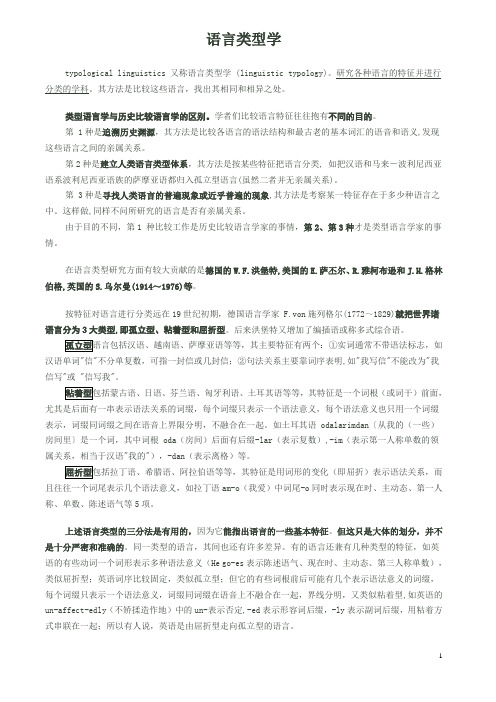
语言类型学typological linguistics 又称语言类型学 (linguistic typology)。
研究各种语言的特征并进行分类的学科。
其方法是比较这些语言,找出其相同和相异之处。
类型语言学与历史比较语言学的区别。
学者们比较语言特征往往抱有不同的目的。
第 1种是追溯历史渊源,其方法是比较各语言的语法结构和最古老的基本词汇的语音和语义,发现这些语言之间的亲属关系。
第2种是建立人类语言类型体系,其方法是按某些特征把语言分类, 如把汉语和马来-波利尼西亚语系波利尼西亚语族的萨摩亚语都归入孤立型语言(虽然二者并无亲属关系)。
第 3种是寻找人类语言的普遍现象或近乎普遍的现象,其方法是考察某一特征存在于多少种语言之中。
这样做,同样不问所研究的语言是否有亲属关系。
由于目的不同,第1 种比较工作是历史比较语言学家的事情,第2、第3种才是类型语言学家的事情。
在语言类型研究方面有较大贡献的是德国的W.F.洪堡特,美国的E.萨丕尔、R.雅柯布逊和J.H.格林伯格,英国的S.乌尔曼(1914~1976)等。
按特征对语言进行分类远在19世纪初期,德国语言学家 F.von施列格尔(1772~1829)就把世界诸语言分为3大类型,即孤立型、粘着型和屈折型。
后来洪堡特又增加了编插语或称多式综合语。
汉语单词"信"不分单复数,可指一封信或几封信;②句法关系主要靠词序表明,如"我写信"不能改为"我信写"或 "信写我"。
尤其是后面有一串表示语法关系的词缀,每个词缀只表示一个语法意义,每个语法意义也只用一个词缀表示,词缀同词缀之间在语音上界限分明,不融合在一起。
如土耳其语 odalarimdan〔从我的(一些)房间里〕是一个词,其中词根 oda(房间)后面有后缀-lar(表示复数),-im(表示第一人称单数的领属关系,相当于汉语"我的"),-dan(表示离格)等。
语言类型学介绍ppt课件.ppt

是学派:语言类型学有自己的语言学理念、特有的研究对 象和研究方法,从而区别于其他主要的语言学流派。
不是学派:功能语言学的一部分,不是一个独立的学派。
病原体侵入机体,消弱机体防御机能 ,破坏 机体内 环境的 相对稳 定性, 且在一 定部位 生长繁 殖,引 起不同 程度的 病理生 理过程
语言共性:语言间的变异受到一定的限制,有一定的变化 模式,这种普遍适应的模式就是一种共性。
6:所有以VSO为优势语序的语言,都可以把SVO作为可能 的或唯一的一种替换性基本语序。
7:在以SOV为优势语序的语言中,如果没有替换语序,或 仅有OSV为替换语序,那么动词所带的一切状语都处于动词 之前。如:We can optimistically predict 。
参考文献:陆丙甫《当代语言学》。
类型学比较的前提:语言类型变化的限制
病原体侵入机体,消弱机体防御机能 ,破坏 机体内 环境的 相对稳 定性, 且在一 定部位 生长繁 殖,引 起不同 程度的 病理生 理过程
语言类型和语言共性的关系
对立:语言共性研究是找人类语言共有的特性;
语言类型化必须是语言之间存在差异。
研究语言间相似点和研究语言间相异点的对立。
病原体侵入机体,消弱机体防御机能 ,破坏 机体内 环境的 相对稳 定性, 且在一 定部位 生长繁 殖,引 起不同 程度的 病理生 理过程
魏列曼与莱曼
动宾结构的核心地位 语序演变的动因
病原体侵入机体,消弱机体防御机能 ,破坏 机体内 环境的 相对稳 定性, 且在一 定部位 生长繁 殖,引 起不同 程度的 病理生 理过程
(二)优势语序的发现
1:带有名词性主语和宾语的陈述句中,优势语序几 乎总是主语处于宾语之前。
- 1、下载文档前请自行甄别文档内容的完整性,平台不提供额外的编辑、内容补充、找答案等附加服务。
- 2、"仅部分预览"的文档,不可在线预览部分如存在完整性等问题,可反馈申请退款(可完整预览的文档不适用该条件!)。
- 3、如文档侵犯您的权益,请联系客服反馈,我们会尽快为您处理(人工客服工作时间:9:00-18:30)。
Ⅱ. Empirical Dimensions of Linguistic
2.2 Tense Typology 2.2.1 Absolute Tense If a language combines all three tenses, then we essentially have a tenseless language. e.g. In Chinese, 我去学校了。 Past
形态 词序 格标 音位 人标 时态体 词性
及物性 类型学 句法
语态
语义
语法
Ⅱ. Empirical Dimensions of Linguistic
Typology
Typology of Tense, Aspect, and Modality Systems
Ferdinand de Haan
This article is concerned with the notions of tense, aspect, and modality from a typological point of view. It provides an overview of the major areas of ongoing research and also a description of where the three areas overlap or not.
Traditionally, the semantic category of tense is usually defined as the linguistic representation of time. That is, tense tells us where the action or event reported on in the utterance is located in time (past, present, or future).
Reichenbach (1947) (also see Comrie 1985a)
Ⅱ. Empirical Dimensions of Linguistic
2.2 Tense
Typology
Tense
Absolute Tense Relative Tense
When S = R*, we are speaking of absolute tense.
Ⅱ. Empirical Dimensions of Linguistic
2.2 Tense Typology 2.2.1 Absolute Tense In Yagua, there are five distinctions: two proximate tenses and three past tenses. They are exemplified below:
*Introduction to The Oxford Handbook of Linguistic Typology
Agenda
Ⅰ. General Introduction
Ⅱ. Empirical Dimensions of Linguistic Typology Ⅲ. Conclusion
Ⅰ. General Introduction
Ⅱ. Empirical Dimensions of Linguistic
2.2 Tense
Typology
Tense
Absolute Tense Relative Tense
When R ≠ S, we speak of relative tense. In the sentence John had left by 5:00 yesterday, E takes place before R (5:00 yesterday), which in turn takes place before S (now). E is measured against R and, secondarily, against S.
Ⅱ. Empirical Dimensions of Linguistic
2.2 Tense Typology 2.2.1 Absolute Tense In Yagua, there are five distinctions: two proximate tenses and three past tenses. They are exemplified below:
And the 30 papers can be divided into 4 large thematic parts: Part Ⅰ Foundations History, Theory, and Method (6 Papers) Part Ⅱ Theoretical Dimensions of Linguistic Typology (6 Papers) Part Ⅲ Empirical Dimensions of Linguistic Typology (12 Papers) Part Ⅳ Linguistic Typology in a Wider Context (6 Papers)
Ⅱ. Empirical Dimensions of Linguistic
2.2 Tense Typology But in the typological framework, the basic idea is to describe tenses with three parameters:
do did will do present past future
Ⅱ. Empirical Dimensions of Linguistic
2.2 Tense Typology 2.2.1 Absolute Tense It can also occur that a language uses the same form for two or more tenses. If a language combines past and present tense, we have a future/nonfuture opposition.
我去学校了。 Present
我去学校了。 Future
Ⅱ. Empirical Dimensions of Linguistic
2.2 Tense Typology 2.2.1 Absolute Tense In many languages, even finer distinctions can be made in the tense system by adding degrees of remoteness. It will usually do so in the past rather than in the future (there are no remoteness distinctions in the present) .
Ⅱ. Empirical Dimensions of Linguistic
2.2 Tense Typology 2.2.1 Absolute Tense As mentioned above, there are three absolute tenses: present, past, and future. It can be that a language formally distinguishes between all three in having separate transcription for each tense. e.g. In English,
Ⅱ. Empirical Dimensions of Linguistic
Typology of Tense, Aspect, and Modality Systems Typology
Ferdinand de Haan
2.1 Introduction
TAM should be viewed not top-down but bottom-up. (Joan Bybee, 1985)
Tense, aspect, modality in English, Russian, Chinese,… English Progressive, Russian Perfect, Chinese Present,…
Ⅱ. Empirical Dimensions of Linguistic
2.2 Tense Typology
Situation time (S), the time at which the statement was uttered; Event time (E), the time at which the event described in the utterance takes place; Reference time (R), the time against which E is measured.
Georg von der Gablentz was the founder of modern linguistic typology. Gabelentz taught himself Dutch, Italian and Chinese during his gymnasium (大学预科) years. and he earned his doctoral from Dresden in 1876 with a translation of Zhou Dunyi’s Taiji Tushuo (太极图说 "Explaining Taiji”).
When E comes before S(R), we are dealing with past tense; when E and S(R) are identical (or at least overlap), the present tense must be usS(R), we have an instance of future tense.
